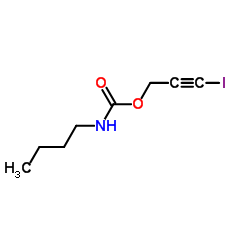Iodopropynyl butylcarbamate

Iodopropynyl butylcarbamate structure
|
Common Name | Iodopropynyl butylcarbamate | ||
|---|---|---|---|---|
| CAS Number | 55406-53-6 | Molecular Weight | 281.091 | |
| Density | 1.5±0.1 g/cm3 | Boiling Point | 321.2±44.0 °C at 760 mmHg | |
| Molecular Formula | C8H12INO2 | Melting Point | 64-68 °C(lit.) | |
| MSDS | Chinese USA | Flash Point | 148.1±28.4 °C | |
| Symbol |




GHS05, GHS06, GHS08, GHS09 |
Signal Word | Danger | |
|
Hand dermatitis: a focus on allergic contact dermatitis to biocides.
Dermatol. Clin. 27(3) , 251-64, v-vi, (2009) Hand dermatitis is a common disease of the skin resulting in significantly decreased quality of life. Allergic contact dermatitis is a frequent cause of hand dermatitis. Recent studies have revealed that biocides used as preservatives are frequent allergens a... |
|
|
New and emerging cosmetic allergens.
Clin. Dermatol. 29(3) , 311-5, (2011) Human skin is exposed to a large variety of cosmetic allergens. Most allergic contact dermatitis occurs after exposure to fragrance, preservatives, and hair dyes. Such reactions can often be occult. As a result, a high index of suspicion is needed in assessin... |
|
|
Temporal trends of preservative allergy in Denmark (1985-2008).
Contact Dermatitis 62(2) , 102-8, (2010) Most cosmetics and industrial products contain preservatives. Preservative allergy is common and, historically, changing contact allergy epidemics caused by preservatives have been observed. In 1997, Alan Dillarstone predicted a stable development of preserva... |
|
|
Mixture toxicity of wood preservative products in the fish embryo toxicity test.
Environ. Toxicol. Chem. 31(6) , 1239-48, (2012) Wood preservative products are used globally to protect wood from fungal decay and insects. We investigated the aquatic toxicity of five commercial wood preservative products, the biocidal active substances and some formulation additives contained therein, as... |
|
|
Method development for the determination of wood preservatives in commercially treated wood using gas chromatography-mass spectrometry.
Anal. Chim. Acta 702(2) , 205-12, (2011) Fungicides and insecticides are commonly used preservatives to protect wood products against microbiological degradations. Currently, there is a lack of analytical methods addressing the quantitative determination of a wide range of wood preserving species in... |
|
|
Monitoring of antifouling booster biocides in water and sediment from the port of Osaka, Japan.
Arch. Environ. Contam. Toxicol. 48(3) , 303-10, (2005) Concentrations of booster antifouling compounds in the port of Osaka, Japan were assessed. Concentrations of Sea-Nine 211 (4,5-dichloro-2-n-octyl-3-isothiazolone), thiabendazole (2-(4-thiazolyl)-benzimidazole), IPBC (3-iodo-2-propynyl butylcarbamate), Diuron ... |
|
|
Iodopropynylbutyl carbamate 0.2% is suggested for patch testing of patients with eczema possibly related to preservatives.
Br. J. Dermatol. 151(3) , 608-15, (2004) Iodopropynyl butylcarbamate (IPBC) is a new preservative in medical and cosmetic leave-on products. Although cases of allergic contact dermatitis to IPBC have been reported, it is not known whether the usual test concentration of 0.1% is appropriate for scree... |
|
|
Antimicrobial activity of lavender, tea tree and lemon oils in cosmetic preservative systems.
J. Appl. Microbiol. 107(6) , 1903-11, (2009) The aim of the study was to verify the antimicrobial activity of commercial essential oils: lavender, tea tree and lemon as the components of a preservative system in oil in water body milks.The inhibition efficacy of essential oils alone (0.5%), in mixtures ... |
|
|
Rapid quantification of iodopropynyl butylcarbamate as the preservative in cosmetic formulations using high-performance liquid chromatography-electrospray mass spectrometry.
J. Pharm. Biomed. Anal. 25(5-6) , 965-70, (2001) A simple, rapid and reproducible method for identification and quantification of iodopropynyl butylcarbamate (IPBC) in different cosmetic formulations is presented. The determination was carried out using a high-performance liquid chromatography (HPLC) proced... |
|
|
[Anal and palmar contact dermatitis caused by iodopropynyl butylcarbamate in moist sanitary wipes].
Hautarzt 54(10) , 970-4, (2003) A 63-year old man developed severe perianal and palmar contact dermatitis caused by sensitization to iodopropynyl butylcarbamate in moist sanitary wipes. Iodopropynyl butylcarbamate is increasingly employed as preservative in common cosmetic formulations and ... |